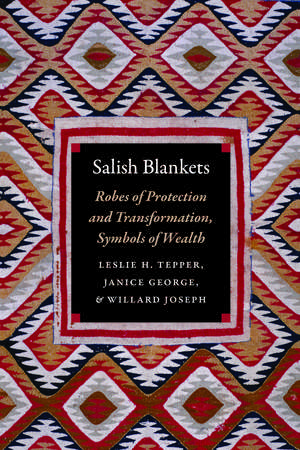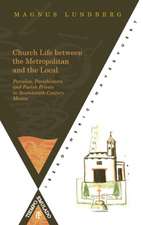Salish Blankets: Robes of Protection and Transformation, Symbols of Wealth
Autor Leslie H. Tepper, Janice George, Willard Josephen Limba Engleză Paperback – 30 iun 2017
Salish Blankets presents a new perspective on Salish weaving through technical and anthropological lenses. Worn as ceremonial robes, the blankets are complex objects said to preexist in the supernatural realm and made manifest in the natural world through ancestral guidance. The blankets are protective garments that at times of great life changes—birth, marriage, death—offer emotional strength and mental focus. A blanket can help establish the owner’s standing in the community and demonstrate a weaver’s technical expertise and artistic vision. The object, the maker, the wearer, and the community are bound and transformed through the creation and use of the blanket.
Drawing on first-person accounts of Salish community members, object analysis, and earlier ethnographic sources, the authors offer a wide-ranging material culture study of Coast Salish lifeways. Salish Blankets explores the design, color/pigmentation, meaning, materials, and process of weaving and examines its historical and cultural contexts.
Drawing on first-person accounts of Salish community members, object analysis, and earlier ethnographic sources, the authors offer a wide-ranging material culture study of Coast Salish lifeways. Salish Blankets explores the design, color/pigmentation, meaning, materials, and process of weaving and examines its historical and cultural contexts.
Preț: 324.28 lei
Nou
Puncte Express: 486
Preț estimativ în valută:
62.05€ • 64.79$ • 51.35£
62.05€ • 64.79$ • 51.35£
Carte disponibilă
Livrare economică 15-29 martie
Preluare comenzi: 021 569.72.76
Specificații
ISBN-13: 9780803296923
ISBN-10: 0803296924
Pagini: 224
Ilustrații: 47 color photographs, 13 illustrations, 1 map, 11 tables, 2 appendixes, index
Dimensiuni: 152 x 229 x 13 mm
Greutate: 0.48 kg
Editura: Nebraska
Colecția University of Nebraska Press
Locul publicării:United States
ISBN-10: 0803296924
Pagini: 224
Ilustrații: 47 color photographs, 13 illustrations, 1 map, 11 tables, 2 appendixes, index
Dimensiuni: 152 x 229 x 13 mm
Greutate: 0.48 kg
Editura: Nebraska
Colecția University of Nebraska Press
Locul publicării:United States
Notă biografică
Leslie H. Tepper is the curator of Western ethnology at the Canadian Museum of History. She is the author of Earthline and Morning Star: Nlaka’pamux Clothing Traditions and coauthor of Legends of Our Times: Native Cowboy Life. Janice George (Chepximiya Siyam) is a co-owner (along with Willard Joseph) of the L’hen Awtxw: The Weaving House studio. She is a hereditary chief of a Squamish family. Willard Joseph (Skwetsimltexw), the great-great-grandson of Harriett Johnnie, weaves and teaches.
Cuprins
List of Illustrations
List of Tables
Acknowledgments
Introduction
List of Abbreviations
1. Framework
2. A Weaving Legacy
3. The Weavings
4. Color and Motif
5. Great Weavings
6. Merged Objects
Finis
Appendix 1: Teachings and Stories
Appendix 2: Salish Textiles in Museum Collections
Notes
Bibliography
Index
List of Tables
Acknowledgments
Introduction
List of Abbreviations
1. Framework
2. A Weaving Legacy
3. The Weavings
4. Color and Motif
5. Great Weavings
6. Merged Objects
Finis
Appendix 1: Teachings and Stories
Appendix 2: Salish Textiles in Museum Collections
Notes
Bibliography
Index
Recenzii
"A nice addition to general Salish ethnography."—M. Ebert, CHOICE
"Through its portrait of artistic practices past and present, and the working intercultural relationships that bring them into public view, this beautifully designed book represents the future of indigenous material culture studies. In its collaborative character, Salish Blankets unites heritage professionals and artists, who articulate individual interests on their own terms, and forges institutional connections among Native communities, museums, and distant nations, projecting ancient and present cultural practices across boundaries of time and geography. It is a literary act of reconciliation and an educational celebration, a most welcome contribution to museum and indigenous studies."—Robert E. Walls, Journal of Folklore Research
"Salish Blankets: Robes of Protection and Transformation, Symbols of Wealth, draws on first-person accounts from Salish community members to offer a comprehensive look at the technical skills involved in weaving. It also examines the numerous ways that weaving plays an important role in Salish and Indigenous culture, both now and historically."—Ben Bengston, North Shore News
"Salish Blankets: Robes of Protection and Transformation, Symbols of Wealth contributes to an emerging collaborative literature documenting Salish art and material heritage through the centuries."—Kaitlin McCormick, Canadian Journal of Native Studies
"The research team of Leslie Tepper, Chepximiya Siyam (Janice George), and Skwetsimltexw (Willard Joseph) achieved their goals by triangulating between three sources of information—the physical blankets in museum collections, archival records and publications concerned with Salish weaving and culture, and contemporary teachings about the Salish worldview and the craft. Their methodical approach is an exciting step in the right direction and, by the authors' own admission, a ready platform for others to build upon."—Ann Lane Hedlund, Pacific Northwest Quarterly
"Somehow Coast Salish blankets, despite embodying complex knowledge of fibres and outstanding skill in spinning, design, and weaving, have remained relatively unknown. Salish Blankets aims to change this by highlighting and explaining the exquisiteness and importance of these blankets."—Liz Hammond-Kaarremaa, BC Book Look
“This book does so many things well. . . . The sensitive and intelligent discussion reveals the difficulties of research and interpretation of an art form that was changing and in flux for many generations. . . . The authors have nimbly stitched together the fragments to create a whole.”—Barbara Brotherton, curator of Native American art at the Seattle Art Museum
“These three authors have thought of us and those yet to come . . . so this ancient/contemporary craft and art may be understood and continued in a modern world.”—annie ross, Indigenous weaver and associate professor in the Department of First Nations Studies at Simon Fraser University










